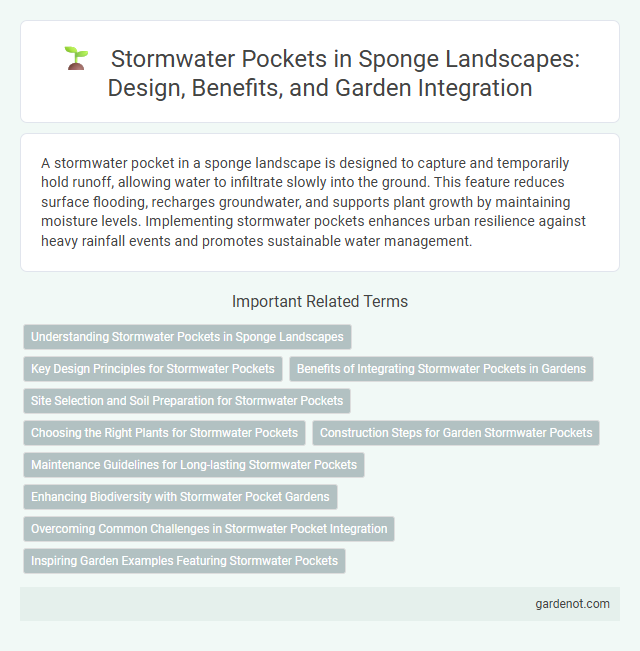A stormwater pocket in a sponge landscape is designed to capture and temporarily hold runoff, allowing water to infiltrate slowly into the ground. This feature reduces surface flooding, recharges groundwater, and supports plant growth by maintaining moisture levels. Implementing stormwater pockets enhances urban resilience against heavy rainfall events and promotes sustainable water management.
Understanding Stormwater Pockets in Sponge Landscapes
Stormwater pockets in sponge landscapes act as localized depressions that temporarily collect and infiltrate runoff, reducing surface water accumulation and promoting groundwater recharge. These pockets are strategically integrated with permeable soils and vegetation to enhance water retention and natural filtration, mitigating flood risks and improving urban water quality. Effective design of stormwater pockets leverages hydrological modeling to optimize placement and capacity, ensuring resilience in varied rainfall patterns.
Key Design Principles for Stormwater Pockets
Stormwater pockets are designed with permeability and infiltration as core principles, enabling efficient capture and groundwater recharge. Utilizing native vegetation enhances pollutant removal and supports local biodiversity within the sponge landscape framework. Proper sizing according to catchment area and runoff volume ensures optimal stormwater management and flood mitigation.
Benefits of Integrating Stormwater Pockets in Gardens
Integrating stormwater pockets in gardens enhances water infiltration and reduces surface runoff, promoting sustainable urban drainage. These localized depressions capture and store rainwater, supporting plant growth and improving soil moisture retention. Stormwater pockets also mitigate flooding risks and filter pollutants, contributing to healthier ecosystems and resilient landscapes.
Site Selection and Soil Preparation for Stormwater Pockets
Selecting an optimal site for a stormwater pocket involves assessing soil permeability, topography, and existing drainage patterns to ensure efficient water infiltration and storage. Soil preparation includes amending compacted or clay-heavy soils with organic matter or sand to increase infiltration rates and prevent waterlogging. Careful consideration of slope and surrounding vegetation helps maximize stormwater absorption and minimize erosion within the sponge landscape system.
Choosing the Right Plants for Stormwater Pockets
Selecting native, water-tolerant plants such as sedges, rushes, and wetland grasses enhances stormwater pocket functionality by improving water infiltration and pollutant filtration. Deep-rooted species like switchgrass and blue flag iris stabilize soil, reduce erosion, and increase the pocket's capacity to manage stormwater runoff effectively. Incorporating diverse plant species promotes habitat diversity and strengthens the resilience of stormwater management systems in urban sponge landscapes.
Construction Steps for Garden Stormwater Pockets
Constructing garden stormwater pockets involves excavating a designated area to create a shallow basin designed to capture and infiltrate runoff water effectively. Incorporate layers of gravel and sand to enhance drainage, followed by the installation of a permeable soil mix tailored to support plant growth and water absorption. Finally, select native, water-tolerant plants to stabilize the soil and maximize the stormwater pocket's capacity for natural water filtration and groundwater recharge.
Maintenance Guidelines for Long-lasting Stormwater Pockets
Regular inspection and removal of debris and sediment are essential for maintaining stormwater pockets in sponge landscapes. Ensuring the functionality of inlet and outlet structures prevents clogging and waterlogging. Periodic vegetation care, including pruning and replacing plants suited for water absorption, enhances filtration and prolongs system efficiency.
Enhancing Biodiversity with Stormwater Pocket Gardens
Stormwater pocket gardens play a crucial role in enhancing urban biodiversity by creating small-scale, habitat-friendly spaces that support diverse plant and animal species. These gardens filter and absorb runoff, reducing pollution while providing essential resources for pollinators, birds, and beneficial insects. Incorporating native vegetation within stormwater pockets optimizes ecological benefits, fostering resilient ecosystems and improving water quality in urban landscapes.
Overcoming Common Challenges in Stormwater Pocket Integration
Stormwater pocket integration faces challenges such as soil compaction, poor drainage, and limited space in urban landscapes. Implementing permeable soils and engineered filtration layers enhances water infiltration and mitigates runoff while maintaining the pocket's functionality. Advanced design techniques including strategic placement and native vegetation selection optimize stormwater management and support sustainable urban ecosystems.
Inspiring Garden Examples Featuring Stormwater Pockets
Stormwater pockets in sponge landscapes enhance water management by capturing and slowly releasing runoff, reducing erosion and promoting groundwater recharge. Inspiring garden examples include the Chicago Botanic Garden, where strategically placed stormwater pockets support native plantings and create vibrant, resilient ecosystems. These designs showcase how integrating stormwater pockets fosters biodiversity and sustainable urban gardening.
Stormwater pocket Infographic

 gardenot.com
gardenot.com